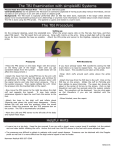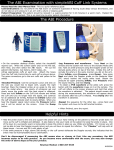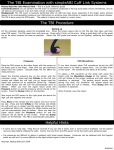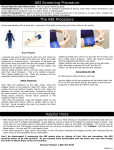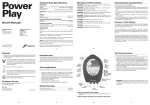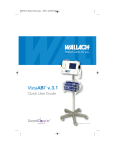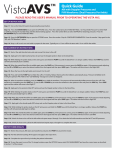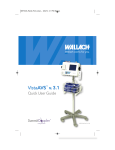Transcript
The ABI Examination with simpleABI Systems Please Read the User Manual first– This is a quick reference guide Contraindications: Do not perform the ABI exam on someone suspected of having acute deep venous thrombosis, and do not take an arm pressure in an arm with a shunt or dialysis graft. Patient Preparation: The patient should be relaxed in a supine position for 5-10 minutes in a warm room. Explain the examination to the patient. This is an ideal time to enter patient information The ABI Procedure • On the computer desktop screen, select the simpleABI reports icon. When the screen opens click on the File tab, then New, and then select the ABI report. Fill out the patient information, risk factors, ICD-9 codes, etc. •Wrap appropriate cuffs at each site – generally 12cm cuffs on the arms and 10cm cuffs on the ankles. Arm Pressure Ankle Pressures • Connect the hose to the right arm cuff. Place the Doppler probe at an angle to the skin over either the radial (preferred) or brachial artery. Use plenty of ultrasonic gel and slowly move the probe until the best signal is obtained. •Inflate the cuff until you no longer hear the signal, and continue for an additional 20 mmHg. •Slowly bleed pressure down until the signal returns and note that return pressure. This is the systolic pressure. Then rapidly deflate the cuff. Enter the pressure into the respective brachial field on the report. •Now take the pressures at the right ankle, using the Doppler probe on the posterior tibial (PT) artery, which is usually found just behind (roughly half an inch- about the diameter of a dime) the ankle bone. Occlude the artery in the same manner you did on the arm in the previous step, noting return pressure. Record return pressure in the respective field on report. • Now take the pressure at the foot using the Doppler probe on the dorsalis pedis (DP) artery, which is usually right on top of the foot. To avoid occluding the arteries by pressing too hard with the probe, be gentle. •Inflate and bleed the cuff as you did with the PT artery and arm, noting return pressure. Enter the systolic pressure into the respective DP field on the report. PVR Waveform Move the hose to the ankle cuff and inflate to ~75mmHg and then bleed to 65mmHg. (the green bar should be about in the center of its box). Set aneroid on exam table when finished bleeding pressure to avoid affecting waveforms with your movement. Press or click ‘Right PVR’ button. A pop-up window will appear; press or click ‘Get Waveform’. simpleABI Reporting software will take 5 seconds of PVR waveforms and return to form. If waveform is acceptable, proceed to the ankle pressures. You can click again on the “Get Waveform” box if you are not satisfied with the waveform. •When finished with the right side move to the left ankle. •Start by obtaining a PVR waveform on the left ankle. •Then take the ankle pressures at the PT and the DP. •Follow by taking the left brachial arm pressure. •When finished, save the report. Helpful Hints • Hold the probe close to the end and support the probe with your hand resting on the patient so that the probe does not move as the cuff is inflated and deflated. It also helps to rest your hand on the patient to keep the probe in place. One of the keys to a successful exam is being able to keep the probe in place as you inflate and deflate. If it moves you will not be able to hear the Doppler sounds return and you will have to repeat the inflation. The “Cheater” will help with all these issues – be sure and fill it with plenty of gel. • If the ankle pressure is high, above 200 mmHg, or the cuff cannot obliterate the Doppler sounds, this indicates that the artery may be incompressible due to calcification. Don’t be discouraged if measuring the ABI seems slow or clumsy at first. Like any procedure, the ABI becomes easier to do with practice. As you become more comfortable with the exam, you may also change the order of above steps as fits your practice. Newman Medical 1-800-267-5549 NM0013-F
